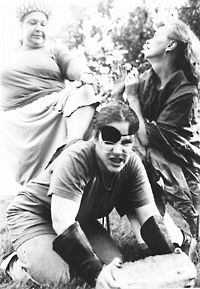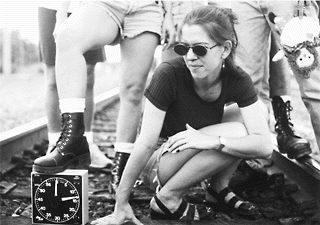Exhibitionism
Deviant Craft: False Fabric
Fri., June 13, 1997
through June 28
Running Time: 2 hrs, 10 min (but can vary)
 Theatre is a fabric of lies, carefully woven to illuminate a greater truth, probably one of the medium's greatest strengths. While the drama is live and onstage, the lines between truth and falsehood blur, but once the final bows are taken, the actors are just plain folks, the intense sunlight is just a few fresnels, and the impassioned utterances are just ink on a page. The amazing thing is that we believe it at all. Like a good magic trick, we know it is one large lie designed to produce a desired response, but we choose to ignore our intellect and instead believe the sleight of hand.
Theatre is a fabric of lies, carefully woven to illuminate a greater truth, probably one of the medium's greatest strengths. While the drama is live and onstage, the lines between truth and falsehood blur, but once the final bows are taken, the actors are just plain folks, the intense sunlight is just a few fresnels, and the impassioned utterances are just ink on a page. The amazing thing is that we believe it at all. Like a good magic trick, we know it is one large lie designed to produce a desired response, but we choose to ignore our intellect and instead believe the sleight of hand.
Some weave this false fabric better than others. Some are more aware that each carefully spun thread adds to a much larger picture and that each thread must mesh with the ones near it, otherwise the whole creation is full of deep rents and ragged holes. Which is why Deviant Craft, produced by Frontera@Hyde Park Theatre, is so amazing. It builds its lie-cloth so well that it flies out of the artists' hands and wraps itself around your head, blocking out most of the input from your left brain. The spaces between the threads are almost invisible, and you begin to believe that this is reality, despite what you may know to be true.
But this is not a cloth that everyone would admire. Its presentation is confrontational and unusual, though it doesn't take itself too seriously. Its strength is its brash colors and electric fibers. Yes, there are some places that are thin enough to see where the weaver couldn't find the perfect thread but did the best he could with what he had, and places where the weaver's hand becomes a bit too obvious. But these are observations that only come after the curtain comes down and reason is re-instated. Also, this is an accessible piece of eclectic fabric for those looking for something besides the more traditional cotton or wool.
To describe too much of what happens during this carefully constructed odyssey would be to snip apart some of the lies that have been created and vastly change a newcomer's view of this material. Instead, some advice for engaging with this weave: Be patient. Play the game. Ask questions. Open your eyes. Believe the falsehood.
-- Adrienne Martini
Too Much Light Makes the Baby Go Blind: Play Full
Electric Lounge
through June 28
Running time: 1 hr
|
|
In the theatrical free-for-all Too Much Light Makes the Baby Go Blind, a gang of Chicago theatre artists called the Neo-Futurists has done its darnedest to defy whatever preconceptions you might have about what makes a play. They have created a catalogue of short plays - very short: three minutes or less - some of which barely begin before they end, some of which lurch from start to finish without a whisper of conflict, some of which are peopled principally by toys. They sketch out situations, throw a satirical punch, a dramatic jab, and scoot. Some may call them scenes or gags or "performance pieces." Their creators call them plays.
Austin's own Rude Mechanicals have got hold of a batch of these Neo-Futurist plays and are presenting them at the Electric Lounge in the literally trademarked style of the pieces' creators, that is, 30 Plays in 60 Minutesreg.. The Mechanicals hand out menus that list the plays with numbers by the titles, tell the audience that it will dictate the order of performance by shouting out the numbers of the plays, hit the one-hour time clock that sits prominently on the stage, and go, charging through 30 works in... well, you know.
In the manic hour of performance, the six actors in the Austin production prove themselves well-suited to the material. They race into place at the start of scenes, make sweeping gestures, shout, sneer, grin, pop their eyes. In the Chekhovian spoof Uncle Vodka, they douse each other with cup after cup of water, soaking shirts, faces, hair, stage. In the ridiculously silly gimmick play Deja Chicken, they repeat the scene they just concluded in henspeak, enthusiastically clucking all the dialogue like giddy geeks. Always they are physically engaged, and their energy and boldness of choice helps these short, punchy scenes connect with the crowd like boxers' blows. It jazzes the crowd, too, so that when six members of the audience are recruited to play all the roles in Understudy (this reviewer was one), they do so with verve.
In the end, a play is not best defined by a formal set of characteristics. A play is what you make it. What the Mechanicals make is a revel, an exuberant celebration of play - the verb - in which the artists join with the audience to make believe, to dream, to invent new worlds, new places to be. With plays such as that, 30 is hardly enough. Let's have 60! 100! More!!
-- Robert Faires









